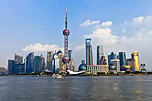| 1. China's Science and Technology Management System |
| National Steering Group on Science, Technology and Education was found in 1998 with Premier Zhu Rongji being its Group leader. Major terms of reference of the Group are: study and review national development strategy and major policies of science, technology and education; discuss and review significant S&T and education tasks and programs; coordinate important relationships related to science, technology and education between different governmental departments and between central government and local governments.
Ministry of Science and Technology (MOST), is a central government agency under the State Council and it is responsible for the nation's science and technology activities. Departments of Science and Technology of various ministries and administrative agencies are responsible for its science and technology activities. Science and Technology Departments or Bureaus in the local governments are responsible for its science and technology activities. There are six main R&D resources in China: Chinese Academy of SciencesR&D institutions under the various ministries and administrative agenciesIndustrial enterprisesUniversities and collegesLocal R&D institutionsR&D institutions affiliated to defense |
| 2.Science and Technology Indicators(not including Hong Kong, Macao and Taiwan) | ||||||||||||||||||||||||||||||||||||||||||||||||||||||||||||||||||||||||||||||||||||||||||||||||||||||||||||
National S&T financing indicators (1995-1999)
GERD*: Gross Domestic Expenditure on R&D As shown by Statistical Bulletin on Investment in S&T in 1999, the China's S&T budget had witnessed a steady growth in the gradually deepened course of S&T system reform. The financial input from the central authorities in S&T activities has been further enhanced with increased enterprises' awareness of investment in R&D of new products. Compared with previous year, however, the growth rate of S&T input at local governmental level has dropped and the increase of R&D expenditures was slowed down. In 1998 S&T budget collected in the nation has reached RMB 128.98 billion, RMB 10.79 billion (9.1%) more than that of previous year; per capita S&T budget in the nation went up by RMB 7.7 Yuan than previous year at RMB 103.3 Yuan. In view of financial sources, the growth rate of funds collected by implementing bodies went faster with a proportion of 50.8% of the total budget collected, 6.2% more than previous year; the proportion of governmental financial support and bank loans were 27.4% and 13.3% of the total respectively, about the same with that of previous year. As shown by preliminary statistics, S&T investment by the national financial has reached RMB 46.65 billion, RMB 5.76 billion (14.1%) up than previous year; the said S&T investment is proportioned 4.3% of the total national financial expenditures, basically at the same level of previous year. S&T investment from central authority sources has seen a faster growth with 10.2% in the total central financial expenditures; S&T investment by local authorities has been slowed down with a proportion of 1.9% in the local total. The total expenditure of S&T funds in the whole year amounted to RMB 112.85 billion in 1998, RMB 6.33 billion (5.9%) more than previous year. Calculated by the number of personnel engaged in the S&T activities, per capita S&T fund expenditure reached RMB 44000, RMB 4000 more than previous year. The S&T expenditures from implementing bodies such as enterprises, R&D institutions and higher learning institutions reached RMB 53.23 billion, 48.49 billion, 7.32 billion respectively with corresponding growth rates at 8.2%, 2.7% and 16.1%. Their corresponding proportion in the total S&T expenditure were 47.2%, 43% and 6.5% respectively. Being one of the main bodies of S&T investment, large and medium industrial enterprises have maintained a steady growth of their S&T budget with the total amounting to RMB 47.87 billion in the year, RMB 4.03 billion (9.2%) up than previous year. The total expenditure in R&D development of the whole year were RMB 55.11 billion in 1998, RMB 4.19 billion (8.2%) up than previous year with a proportion of 0.69% in the nation's GDP, a bit higher than that of previous year. Per capita R&D budget calculated on personnel engaged in R&D activities were RMB 73000 Yuan, RMB 12000 Yuan more than previous year. In terms of classified research types, the budget for basic research grew slowly with a decrease for applied research against previous year and an increase for experimental development. National S&T personnel indicators (1995-1999)
FTE*: Full-time Equivalent S/E**: Scientists and Engineers National S&T output indicators (1995-1999)
* SCI-Science Citation Index, ISTP-Index to Scientific and Technical Proceedings, EI-Engineering Index The survey results on Chinese S&T papers published and quoted both domestically and internationally (not including Hong Kong, Macao and Taiwan) in 1999 were publicized. Results have shown that in 1999 China had witnessed its 46188 S&T papers published internationally, 3.27% of the total Chinese papers published (1421520). As a result, China jumps to the 8th place after US, Japan, UK, Germany, France, Canada and Italy. The number of Chinese S&T papers quoted internationally has gone up from 9952 to 11549 papers and times quoted from 18434 to 21511 times. The said statistics on papers published internationally came out of three renowned international retrieval indicators, SCI, EI and ISTP, and domestic papers from 1286 national major S&T journals published in 1998. In 1998 Chinese S&T personnel published 161692 papers in domestic journals, 21.26% up than that of previoust year. The areas enjoying most papers published are Beijing, Shanghai and Jiangsu, the universities are Nanjing University, Beijing University and China S&T University. The annually increased Chinese S&T papers published and upgraded position have reflected the bumper harvest of basic studies in the nation. Journals collected by SCI has gone up from 9 to 11 with the ones collected by EI reaching as many as 90. The development has not only shown the increasing number of papers published but also more attention attached to by major international retrieval systems. National R&D indicators in 2000The total expenditure on R&D in 2000 reached RMB 89.6 billion, 17.9% more than that of previous year. With a proportion of 1.0% in the nation's GDP, the total expenditure on basic research, applied research and development were RMB 4.67 billion (5.2%), 15.21 billion (17.0%) and 69.72 billion (77.8%) respectively. It's noted that the basic research expenditure got an increase of RMB 1.22 billion or a growth of 35.3%. The S&T expenditures from implementing bodies such as state-owned R&D institutions, universities and enterprises reached RMB 25.82 billion, 7.66 billion and 54.06 billion respectively with corresponding growth rates at 8.3%, 20.9% and 23.9%. Their corresponding proportion in the total S&T expenditure was 28.8%, 8.6% and 60.3% respectively. Statistics also indicated that the financial support on different industries had been increased with various growth rates. The total funding on R&D for agriculture, forestry, animal husbandry and fishery amounted to RMB 0.77 billion, which is about 0.9% of the total R&D funding. Other industries including light & heavy industry, architecture, geological exploration and water conservancy, transportation and telecommunication, computer application service, health care, education, S&T activities, and comprehensive service systems were financed respectively with amount of RMB 49.0 billion (54.7%), 0.53 billion (0.6%), 0.5 billion (0.6%), 0.97 billion (1.0%), 1.4 billion (1.6%), 1.2 billion (1.3%), 7.36 billion (8.2%), 25.82 billion (28.8%), and 2.05 billion (2.3%). Mmajor indicators of the year 20001. GDP: RMB 8.9404 trillion, 8.0% more than 1999 2. Hi-Tech international trade: Trade volume reached US$ 89.55 billion (43.7% up than last year), in which export occupied US$ 37.043 billion with an increase of 50%. 3. In the fiscal year 2000 the financial allocation on S&T was RMB 57.56 billion, a proportion of 3.6% of the total fiscal expenditure. Among the three special project funds for S&T were RMB 27.72 billion (48.2%), S&T operating expenses was RMB 18.9 billion (32.8%), the expenditure on infrastructure and others was RMB 10.94 billion (19.0%). It should be noted that the funding on S&T from local governments were increasing fast, which was RMB 22.6 billion with a proportion of 2.1% of total fiscal expenditure. The funding on S&T from central government was RMB 34.96 billion, or 6.3% of the total fiscal expenditure. |
| 3.Reforms of the R&D Management System |
| A major S&T reform plan was approved by China's State Council for the implementation. According to this reform plan, 242 research institutions subordinated to 10 governmental agencies under the jurisdiction of National Economy and Trade Commission, in accordance with detailed requirements of industrialization while taking into account their own conditions, shall select their own reform approaches including spinning off into S&T related enterprises, being wholly or partially merged into enterprises or becoming technical service and intermediary firms. A limited number of research institutions who are approved to maintain their existing structures shall also introduce the operational mechanism of S&T enterprises. Research institutions who are required to restructure will work upon the new mechanism starting from July 1st, 1999.
As required by senior officials of State Council, heads of these 242 institutions attended a discussion meeting jointly held by Chinese Ministry of Science and Technology and State Economy and Trade Commission. The major purpose of the meeting is to promote the smooth restructuring of these institutions and accelerate their industrialization. To ensure the smooth restructuring, a number of favorable policies have been worked out in addition to detailed implementation plan. After restructuring, state budget will be made available as before so as to address social security issues such as pension of retired employees. Starting from 1999, the restructured institutions will enjoy exemption of industrial income tax, business tax for technology transfer and land use tax for structural development on their own land in a period of five years. They are also allowed to enjoy import and export rights for their own manufactured goods and state preferential treatment for S&T enterprises, national research programs or projects bidding and other rights enjoyed by similar research institutions. On the platform of national innovation system, the technology development is intensively emphasized as an important issue in the reform. In particular the application research institutions are required to run their business like enterprises, totally in terms of market needs. There were 5014 state-owned R&D institutions above the county level, with a number of 330 thousands researchers. These applied research bodies were asked to become S&T-based enterprises or to merge with business companies by the end of 2000. |
| 4.Major Scientific and Technology Achievements |
| Since the implementation of its S&T blueprint for the 9th Five-Year Plan, China has seen concentrated efforts on tackling a number of key technologies and major progress or remarkable achievements in the first three years.
It is reported that 240 projects and 3600 dedicated topics centering around agriculture, basic industries, pillar industries, high tech industries and social sustainable development were defined by the blueprint with participants of 70000 person-time and a total estimated budget of RMB 19 billion, of which RMB 5 billion comes from state appropriations. During the first three years of the 9th Five-Year Plan period, the state has allocated RMB 3.2 billion for the implementation of blueprint, 65% of the total budget expected from the state. As shown by the mid-term projects inspection and individual major projects appraisal, 90% of the dedicated topics have reached their phased targets on time or in advance with 42% of them reaching international advanced level and an increasing number of projects being directly translated into products for enhanced economic benefits. According to the statistics on 98 projects, the first three years have registered an increased output value of RMB 31.33 billion, net profits of RMB 3.16 billion, paid tax of RMB 540 million and export volume of US$ 330 million. By the end of 1998 the Torch Programlaunched byMOSThad passed its 10-year implementation phrases with a total number of 12599 projects (state level 3536, local level 9063) approved. In 1997 the implementation of theTorch Programresulted in an output of RMB 125.6 billion, revenue of RMB 113.8 billion, profit of RMB 21.2 billion and an export income of US$ 1.77 billion. Statistics shows that by the end of 1997, the total industrial output amounted to RMB 414.7 billion with profit of RMB 72.1 billion and an export income of US$ 6.04 billion. 4548Torch Programprojects were approved on state level during 1988-1998, more than 90% of the projects were based on the technologies developed by China itself. With the support fromTorch Programmore hi-tech pillar industries have been enhanced a lot and are recognized as an incitant of economic development in China. As an important part of theTorch Program,53 national hi-tech development zoneshave been set up since early 1990s and have been taking roles of delivering service systems for technology fostering. There's no doubt that the hi-tech development zones have become the bases for China to develop the hi-tech industries of its own. In 1997 the number of hi-tech companies in the hi-tech development zones reached 13700 and more than 14300 new products were introduced to market, producing an income of RMB 338.8 billion, a industrial output of RMB 310.9 billion, a profit of RMB 34.99 billion and an export income of US$ 6.48 billion. These four indicators were increased within 7 years with annual growth rate of 83.1%, 88.6%, 73.1% and 81.8% respectively. The productivity in the hi-tech development zones rose as much as four times from RMB 52000 per capita per year in 1991 to 230000 RMB in 1997. The number of hi-tech enterprises with revenue of over RMB 100 million has reached 530 since 1991 when there were only 7 hi-tech companies. In addition, 47 large-scale companies have reached the revenue of more than RMB 1 billion each but no one could achieved so much in 1991. Nowadays five hi-tech development zones in Beijing, Suzhou, Hefei, Xi'an and Yantai have been issued to open to the members of APEC. |
1. China's Science and Technology Management System
National Steering Group on Science, Technology and Education was found in 1998 with Premier Zhu Rongji being its Group leader. Major terms of reference of the Group are: study and review national development strategy and major policies of science, technology and education; discuss and review significant S&T and education tasks and programs; coordinate important relationships related to science, technology and education between different governmental departments and between central government and local governments.
Ministry of Science and Technology (MOST), is a central government agency under the State Council and it is responsible for the nation's science and technology activities.
Departments of Science and Technology of various ministries and administrative agencies are responsible for its science and technology activities.
Science and Technology Departments or Bureaus in the local governments are responsible for its science and technology activities.
There are six main R&D resources in China:
Chinese Academy of Sciences
R&D institutions under the various ministries and administrative agencies
Industrial enterprises
Universities and colleges
Local R&D institutions
R&D institutions affiliated to defense
2. Science and Technology Indicators (not including Hong Kong, Macao and Taiwan)
National S&T financing indicators (1995-1999)
1995 1996 1997 1998 1999
National S&T financing (100 million Yuan) 962.5 1043.2 1181.9 1289.8 1460.6
National S&T expenditure (100 million Yuan) 846.9 933.0 1065.2 1128.5 1284.9
Govt. S&T appropriation (100 million Yuan) 302.4 348.6 408.9 438.6 544.9
As percentage of total govt. expenditure 4.4 4.4 4.4 4.3 4.1
GERD* (100 million Yuan) 348.7 404.5 509.2 551.1 678.9
As percentage of GDP 0.60 0.60 0.64 0.69 0.83
GERD*: Gross Domestic Expenditure on R&D
As shown by Statistical Bulletin on Investment in S&T in 1999, the China's S&T budget had witnessed a steady growth in the gradually deepened course of S&T system reform. The financial input from the central authorities in S&T activities has been further enhanced with increased enterprises' awareness of investment in R&D of new products. Compared with previous year, however, the growth rate of S&T input at local governmental level has dropped and the increase of R&D expenditures was slowed down.
In 1998 S&T budget collected in the nation has reached RMB 128.98 billion, RMB 10.79 billion (9.1%) more than that of previous year; per capita S&T budget in the nation went up by RMB 7.7 Yuan than previous year at RMB 103.3 Yuan. In view of financial sources, the growth rate of funds collected by implementing bodies went faster with a proportion of 50.8% of the total budget collected, 6.2% more than previous year; the proportion of governmental financial support and bank loans were 27.4% and 13.3% of the total respectively, about the same with that of previous year. As shown by preliminary statistics, S&T investment by the national financial has reached RMB 46.65 billion, RMB 5.76 billion (14.1%) up than previous year; the said S&T investment is proportioned 4.3% of the total national financial expenditures, basically at the same level of previous year. S&T investment from central authority sources has seen a faster growth with 10.2% in the total central financial expenditures; S&T investment by local authorities has been slowed down with a proportion of 1.9% in the local total.
The total expenditure of S&T funds in the whole year amounted to RMB 112.85 billion in 1998, RMB 6.33 billion (5.9%) more than previous year. Calculated by the number of personnel engaged in the S&T activities, per capita S&T fund expenditure reached RMB 44000, RMB 4000 more than previous year. The S&T expenditures from implementing bodies such as enterprises, R&D institutions and higher learning institutions reached RMB 53.23 billion, 48.49 billion, 7.32 billion respectively with corresponding growth rates at 8.2%, 2.7% and 16.1%. Their corresponding proportion in the total S&T expenditure were 47.2%, 43% and 6.5% respectively. Being one of the main bodies of S&T investment, large and medium industrial enterprises have maintained a steady growth of their S&T budget with the total amounting to RMB 47.87 billion in the year, RMB 4.03 billion (9.2%) up than previous year.
The total expenditure in R&D development of the whole year were RMB 55.11 billion in 1998, RMB 4.19 billion (8.2%) up than previous year with a proportion of 0.69% in the nation's GDP, a bit higher than that of previous year. Per capita R&D budget calculated on personnel engaged in R&D activities were RMB 73000 Yuan, RMB 12000 Yuan more than previous year. In terms of classified research types, the budget for basic research grew slowly with a decrease for applied research against previous year and an increase for experimental development.
National S&T personnel indicators (1995-1999)
1995 1996 1997 1998 1999
Personnel engaged in S&T activities (thousand) 2624.7 2903.2 2885.7 2814.5 2905.6
Scientists and Engineers (thousand)
1553.9 1687.8 1667.8 1490.1 1594.6
R&D personnel (FTE* in 1000) 751.7 804.0 831.2 855.2 821.7
Scientists and Engineers (FTE in 1000)
522.0 548.0 588.7 485.5 531.1
S/E** engaged in R&D per 10000 labor force
7.6 7.9 8.3 6.8 6.7
FTE*: Full-time Equivalent
S/E**: Scientists and Engineers
National S&T output indicators (1995-1999)
1995 1996 1997 1998 1999
Number of patent applications (case) 83045 102735 114208 121989 134239
S&T papers catalogued by SCI?ISTP and EI* 26395 27569 35311 35003 46188
Exports of high-tech products (US$100 million) 100.9 126.6 163.1 202.5 247.0
As percentage of total exports
6.8 8.4 8.9 11.0 12.7
* SCI-Science Citation Index, ISTP-Index to Scientific and Technical Proceedings, EI-Engineering Index
The survey results on Chinese S&T papers published and quoted both domestically and internationally (not including Hong Kong, Macao and Taiwan) in 1999 were publicized. Results have shown that in 1999 China had witnessed its 46188 S&T papers published internationally, 3.27% of the total Chinese papers published (1421520). As a result, China jumps to the 8th place after US, Japan, UK, Germany, France, Canada and Italy.
The number of Chinese S&T papers quoted internationally has gone up from 9952 to 11549 papers and times quoted from 18434 to 21511 times. The said statistics on papers published internationally came out of three renowned international retrieval indicators, SCI, EI and ISTP, and domestic papers from 1286 national major S&T journals published in 1998.
In 1998 Chinese S&T personnel published 161692 papers in domestic journals, 21.26% up than that of previoust year. The areas enjoying most papers published are Beijing, Shanghai and Jiangsu, the universities are Nanjing University, Beijing University and China S&T University.
The annually increased Chinese S&T papers published and upgraded position have reflected the bumper harvest of basic studies in the nation. Journals collected by SCI has gone up from 9 to 11 with the ones collected by EI reaching as many as 90. The development has not only shown the increasing number of papers published but also more attention attached to by major international retrieval systems.
National R&D indicators in 2000
The total expenditure on R&D in 2000 reached RMB 89.6 billion, 17.9% more than that of previous year. With a proportion of 1.0% in the nation's GDP, the total expenditure on basic research, applied research and development were RMB 4.67 billion (5.2%), 15.21 billion (17.0%) and 69.72 billion (77.8%) respectively. It's noted that the basic research expenditure got an increase of RMB 1.22 billion or a growth of 35.3%.
The S&T expenditures from implementing bodies such as state-owned R&D institutions, universities and enterprises reached RMB 25.82 billion, 7.66 billion and 54.06 billion respectively with corresponding growth rates at 8.3%, 20.9% and 23.9%. Their corresponding proportion in the total S&T expenditure was 28.8%, 8.6% and 60.3% respectively.
Statistics also indicated that the financial support on different industries had been increased with various growth rates. The total funding on R&D for agriculture, forestry, animal husbandry and fishery amounted to RMB 0.77 billion, which is about 0.9% of the total R&D funding. Other industries including light & heavy industry, architecture, geological exploration and water conservancy, transportation and telecommunication, computer application service, health care, education, S&T activities, and comprehensive service systems were financed respectively with amount of RMB 49.0 billion (54.7%), 0.53 billion (0.6%), 0.5 billion (0.6%), 0.97 billion (1.0%), 1.4 billion (1.6%), 1.2 billion (1.3%), 7.36 billion (8.2%), 25.82 billion (28.8%), and 2.05 billion (2.3%).
Mmajor indicators of the year 2000
1. GDP: RMB 8.9404 trillion, 8.0% more than 1999
2. Hi-Tech international trade: Trade volume reached US$ 89.55 billion (43.7% up than last year), in which export occupied US$ 37.043 billion with an increase of 50%.
3. In the fiscal year 2000 the financial allocation on S&T was RMB 57.56 billion, a proportion of 3.6% of the total fiscal expenditure. Among the three special project funds for S&T were RMB 27.72 billion (48.2%), S&T operating expenses was RMB 18.9 billion (32.8%), the expenditure on infrastructure and others was RMB 10.94 billion (19.0%). It should be noted that the funding on S&T from local governments were increasing fast, which was RMB 22.6 billion with a proportion of 2.1% of total fiscal expenditure. The funding on S&T from central government was RMB 34.96 billion, or 6.3% of the total fiscal expenditure.
3. Reforms of the R&D Management System
A major S&T reform plan was approved by China's State Council for the implementation. According to this reform plan, 242 research institutions subordinated to 10 governmental agencies under the jurisdiction of National Economy and Trade Commission, in accordance with detailed requirements of industrialization while taking into account their own conditions, shall select their own reform approaches including spinning off into S&T related enterprises, being wholly or partially merged into enterprises or becoming technical service and intermediary firms. A limited number of research institutions who are approved to maintain their existing structures shall also introduce the operational mechanism of S&T enterprises. Research institutions who are required to restructure will work upon the new mechanism starting from July 1st, 1999.
As required by senior officials of State Council, heads of these 242 institutions attended a discussion meeting jointly held by Chinese Ministry of Science and Technology and State Economy and Trade Commission. The major purpose of the meeting is to promote the smooth restructuring of these institutions and accelerate their industrialization.
To ensure the smooth restructuring, a number of favorable policies have been worked out in addition to detailed implementation plan. After restructuring, state budget will be made available as before so as to address social security issues such as pension of retired employees. Starting from 1999, the restructured institutions will enjoy exemption of industrial income tax, business tax for technology transfer and land use tax for structural development on their own land in a period of five years. They are also allowed to enjoy import and export rights for their own manufactured goods and state preferential treatment for S&T enterprises, national research programs or projects bidding and other rights enjoyed by similar research institutions.
On the platform of national innovation system, the technology development is intensively emphasized as an important issue in the reform. In particular the application research institutions are required to run their business like enterprises, totally in terms of market needs. There were 5014 state-owned R&D institutions above the county level, with a number of 330 thousands researchers. These applied research bodies were asked to become S&T-based enterprises or to merge with business companies by the end of 2000.
4. Major Scientific and Technology Achievements
Since the implementation of its S&T blueprint for the 9th Five-Year Plan, China has seen concentrated efforts on tackling a number of key technologies and major progress or remarkable achievements in the first three years.
It is reported that 240 projects and 3600 dedicated topics centering around agriculture, basic industries, pillar industries, high tech industries and social sustainable development were defined by the blueprint with participants of 70000 person-time and a total estimated budget of RMB 19 billion, of which RMB 5 billion comes from state appropriations. During the first three years of the 9th Five-Year Plan period, the state has allocated RMB 3.2 billion for the implementation of blueprint, 65% of the total budget expected from the state.
As shown by the mid-term projects inspection and individual major projects appraisal, 90% of the dedicated topics have reached their phased targets on time or in advance with 42% of them reaching international advanced level and an increasing number of projects being directly translated into products for enhanced economic benefits. According to the statistics on 98 projects, the first three years have registered an increased output value of RMB 31.33 billion, net profits of RMB 3.16 billion, paid tax of RMB 540 million and export volume of US$ 330 million.
By the end of 1998 the Torch Program launched by MOST had passed its 10-year implementation phrases with a total number of 12599 projects (state level 3536, local level 9063) approved. In 1997 the implementation of the Torch Program resulted in an output of RMB 125.6 billion, revenue of RMB 113.8 billion, profit of RMB 21.2 billion and an export income of US$ 1.77 billion. Statistics shows that by the end of 1997, the total industrial output amounted to RMB 414.7 billion with profit of RMB 72.1 billion and an export income of US$ 6.04 billion. 4548 Torch Program projects were approved on state level during 1988-1998, more than 90% of the projects were based on the technologies developed by China itself. With the support from Torch Program more hi-tech pillar industries have been enhanced a lot and are recognized as an incitant of economic development in China. As an important part of the Torch Program, 53 national hi-tech development zones have been set up since early 1990s and have been taking roles of delivering service systems for technology fostering. There's no doubt that the hi-tech development zones have become the bases for China to develop the hi-tech industries of its own. In 1997 the number of hi-tech companies in the hi-tech development zones reached 13700 and more than 14300 new products were introduced to market, producing an income of RMB 338.8 billion, a industrial output of RMB 310.9 billion, a profit of RMB 34.99 billion and an export income of US$ 6.48 billion. These four indicators were increased within 7 years with annual growth rate of 83.1%, 88.6%, 73.1% and 81.8% respectively. The productivity in the hi-tech development zones rose as much as four times from RMB 52000 per capita per year in 1991 to 230000 RMB in 1997. The number of hi-tech enterprises with revenue of over RMB 100 million has reached 530 since 1991 when there were only 7 hi-tech companies. In addition, 47 large-scale companies have reached the revenue of more than RMB 1 billion each but no one could achieved so much in 1991. Nowadays five hi-tech development zones in Beijing, Suzhou, Hefei, Xi'an and Yantai have been issued to open to the members of APEC.




